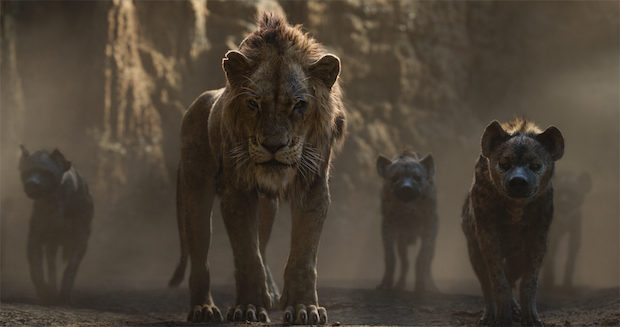Disney’s “The Lion King” : Maggie’s Review

25 years after Simba and a host of now iconic characters first came to the big screen, “The Lion King” returns to theaters Friday with fresh jokes, familiar musical numbers and not a single real animal. The latest of Disney’s live-action revisit of animated favorites, “The Lion King” enjoys many of the same privileges and drawbacks as its predecessors, but falls prey to some unique pitfalls.
Like others before it, this remake is all but a shot for shot remake of its source material. Lion cub Simba (JD McCrary, Donald Glover), heir to the Pride Lands, scuffles with his future bride/sister Nala (Shahidi Wright Joseph, Beyoncé) and gets into all kinds of trouble at the hands of his uncle Scar, a band of hyenas and a herd of wildebeests. After tragedy strikes, Simba runs away to live a more carefree life with Timon (Billy Eichner) and Pumbaa (Seth Rogen) before returning to rescue his pride from the tyrannical rule of Scar.

Director Jon Favreau manages a lot of victories in this film: natural comedic rapport between two foiled dynamic duos, satisfactory utilization of a hilariously star-studded voice cast, and absurd documentary-level photorealism of CGI. Unsurprisingly, the movie is about 30 minutes too long. Surprisingly, while the sensational CGI does not fall into the uncanny valley of the early aughts, this film innovates a new problem, which I will refer to as the Canny Mountain of Hyenas Eating a Lion.

One of the many advantages this film enjoys (and uses liberally) is the buckets of good will it can engender by hitting the right musical cues at just the right time. The original animated feature came to theaters the year I was born and is essentially imprinted on my soul. I will likely forget my own name before I lose the instinctual warm feelings associated with this film’s soundtrack. Favreau uses this to great effect, but not in a way that is so overtly manipulative as to be cloying or slapdash. The voice cast all manage to have perfectly enjoyable musical performances, with few personal deviations from the originals, but some refreshed banter and Easter eggs in the performances of Timon and Pumbaa.
The digital art of this movie is basically flawless. From the twitch of a lion cub’s ear to the tangible weight of a water buffalo’s horns, the CGI succeeds in making it feel truly outrageous that there is, per Favreau’s boasting, only one live shot in the entire film. This hyper-realistic feel means that the film relies much more on body language and textual cues than on the facial expressions that classic animation allows. Simba can not tear up at the loss of his father, so he has to lay on the realization of his death pretty thick. Scar can not actually twist his face in a maniacal smirk or evil snarl, so he has to be mangy and starved in appearance, while his dialogue with the lionesses of the pride makes him predatory in a whole new way.

The downfall of CGI so good is that while it has climbed out of the Uncanny Valley of characters on the wrong side of the line between computer generated and real life, the film fails to recognize the responsibility of story telling in that space. It is hard to watch a lot of scenes in this modern “Lion King” because even if you know that those are not real animals ripping each other apart, boy, they sure look just like real animals ripping each other apart. Scar is a despicable bad guy, but his fate rendered in photorealistic computer generation is still troubling.

So ultimately what makes this film so great is what was there all along: the music and the vocal performances. Billy Eichner pays incredible tribute to Nathan Lane’s Timon, while making it his own. Keegan-Michael Key and Eric Andre add dimension to the usually ominous hyenas, while Florence Kasumba’s Shenzi is regal and vicious in a way that is as compelling if not more so than Chiwetel Ejiofor’s Scar. The most iconic songs and scores of the 1994 movie remain with little update, and are created by many of the same composers and singers. Perhaps because the film’s trailer was so touted for its resemblance to the original, there is no scene left out, so anything new or additional adds minutes to the tight 88 minute runtime of the animated feature. On screen this leaves odd, drawn out sequences of CGI nature that feel, at times, endless.
This film is ultimately a neutral good. It pushes all of the right buttons for automatic joy, puts more Beyoncé in our lives, and cinematography wise is truly a film that could not have been made a single year sooner. However, it is by no means essential. After the nostalgic high fades, I did not have a resounding answer to whether or not this movie needed to be made. “The Lion King” is worth a summer viewing, but fails to achieve what all of these remakes are striving for: necessity.


